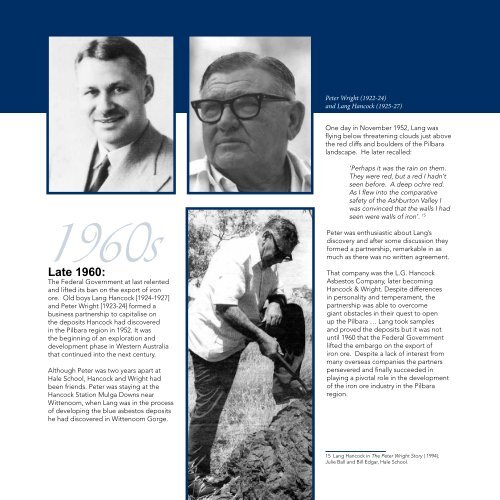The History of Hale School and its Old Boys - Old Haleians Association
The History of Hale School and its Old Boys - Old Haleians Association
The History of Hale School and its Old Boys - Old Haleians Association
You also want an ePaper? Increase the reach of your titles
YUMPU automatically turns print PDFs into web optimized ePapers that Google loves.
1960s<br />
Late 1960:<br />
<strong>The</strong> Federal Government at last relented<br />
<strong>and</strong> lifted <strong>its</strong> ban on the export <strong>of</strong> iron<br />
ore. <strong>Old</strong> boys Lang Hancock [1924-1927]<br />
<strong>and</strong> Peter Wright [1923-24] formed a<br />
business partnership to capitalise on<br />
the depos<strong>its</strong> Hancock had discovered<br />
in the Pilbara region in 1952. It was<br />
the beginning <strong>of</strong> an exploration <strong>and</strong><br />
development phase in Western Australia<br />
that continued into the next century.<br />
Although Peter was two years apart at<br />
<strong>Hale</strong> <strong>School</strong>, Hancock <strong>and</strong> Wright had<br />
been friends. Peter was staying at the<br />
Hancock Station Mulga Downs near<br />
Wittenoom, when Lang was in the process<br />
<strong>of</strong> developing the blue asbestos depos<strong>its</strong><br />
he had discovered in Wittenoom Gorge.<br />
Peter Wright (1922-24)<br />
<strong>and</strong> Lang Hancock (1925-27)<br />
One day in November 1952, Lang was<br />
flying below threatening clouds just above<br />
the red cliffs <strong>and</strong> boulders <strong>of</strong> the Pilbara<br />
l<strong>and</strong>scape. He later recalled:<br />
‘Perhaps it was the rain on them.<br />
<strong>The</strong>y were red, but a red I hadn’t<br />
seen before. A deep ochre red.<br />
As I flew into the comparative<br />
safety <strong>of</strong> the Ashburton Valley I<br />
was convinced that the walls I had<br />
seen were walls <strong>of</strong> iron’. 15<br />
Peter was enthusiastic about Lang’s<br />
discovery <strong>and</strong> after some discussion they<br />
formed a partnership, remarkable in as<br />
much as there was no written agreement.<br />
That company was the L.G. Hancock<br />
Asbestos Company, later becoming<br />
Hancock & Wright. Despite differences<br />
in personality <strong>and</strong> temperament, the<br />
partnership was able to overcome<br />
giant obstacles in their quest to open<br />
up the Pilbara … Lang took samples<br />
<strong>and</strong> proved the depos<strong>its</strong> but it was not<br />
until 1960 that the Federal Government<br />
lifted the embargo on the export <strong>of</strong><br />
iron ore. Despite a lack <strong>of</strong> interest from<br />
many overseas companies the partners<br />
persevered <strong>and</strong> finally succeeded in<br />
playing a pivotal role in the development<br />
<strong>of</strong> the iron ore industry in the Pilbara<br />
region.<br />
15 Lang Hancock in <strong>The</strong> Peter Wright Story ( 1994),<br />
Julie Ball <strong>and</strong> Bill Edgar, <strong>Hale</strong> <strong>School</strong>.


